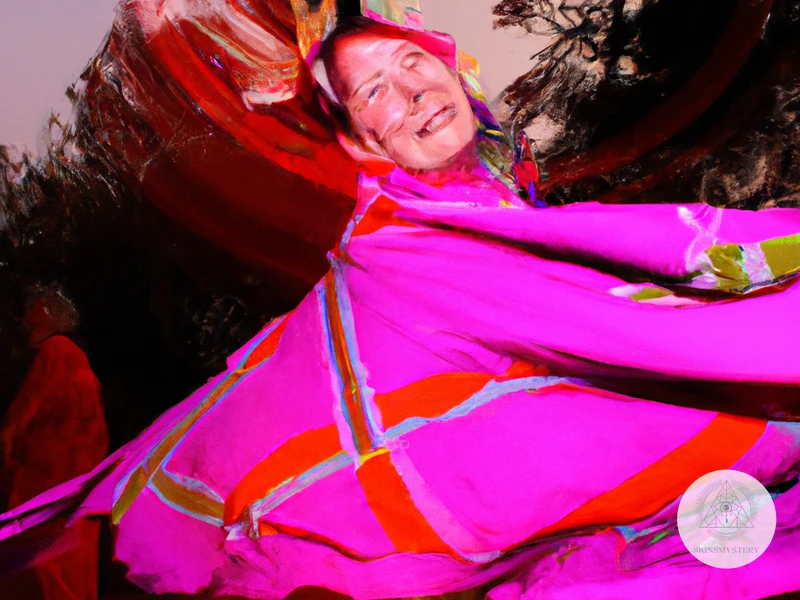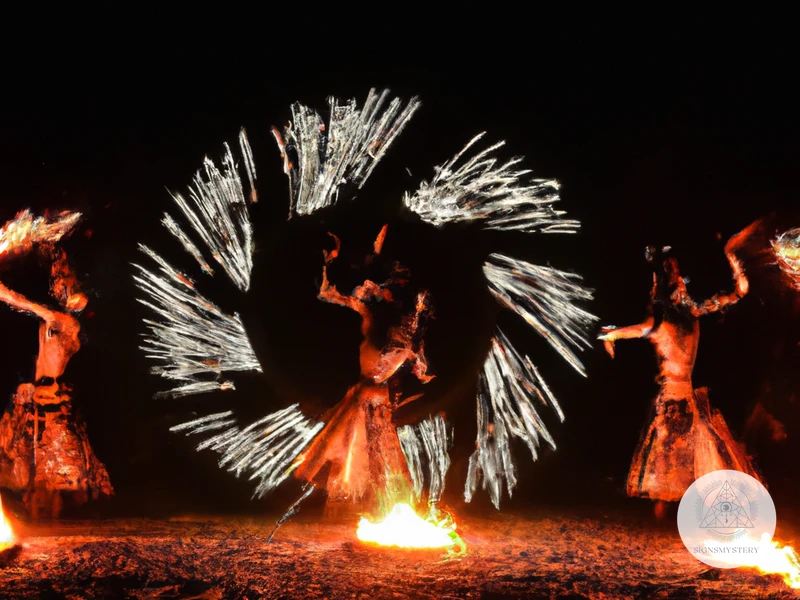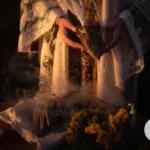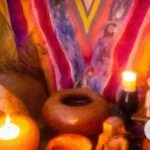Shamanism has been practiced for thousands of years, and shamanic dance is an integral part of many spiritual ceremonies. But what exactly is shamanic dance? And what role does it play in these ancient and modern-day rituals? In this article, we will explore the purpose, techniques, and cultural significance of shamanic dance. We will also examine the benefits of this powerful practice, including spiritual healing, personal empowerment, and connection to ancestral wisdom. So, if you’re curious about the mystical world of shamanism, let’s dive in and discover the transformative power of shamanic dance.
Defining Shamanic Dance
Shamanic dance is a form of movement that has been used for centuries, perhaps even millennia, in spiritual and religious rituals. It is a dance that is performed in a specific way, often involving specific music, costumes, and movements. The dance is often used as a way to connect with the spiritual realm, to enter altered states of consciousness, and to generate energy for specific purposes. Ancient shamanic chanting and the use of sacred plants often accompany shamanic dance. Shamanic dance is a way for a person to connect with the divine and the universe, and to tap into their own personal power and wisdom.
The Spirituality of Shamanic Dance
The spirituality of Shamanic Dance is the heart of Shamanic rituals. It is a sacred practice that allows participants to honor the spirits and connect with the divine. The dance is a form of prayer that enhances the collective energy of the group and helps to create a space where spirits and humans can come together.
One of the central beliefs in Shamanism is that everything has a spirit, and this includes the music, the movements, and the energy generated during the dance. When dancers engage in Shamanic dance, they are seeking to connect with these spirits through their movements and rhythms. This connection allows them to communicate with the spirits and receive guidance and wisdom.
Shamanic dance is a transformative experience that helps the dancer to transcend the physical world and enter into a spiritual realm. This experience helps to open the heart and mind to the divine and to gain a deeper understanding of the self and the world around us.
During Shamanic dance, participants may experience various sensations, such as tingling, warmth or coldness, visions, or a feeling of being in an altered state of consciousness. These sensations are considered to be signs that the spirits are present and that the dance is having a profound effect on the dancer’s spiritual well-being.
Shamanic dance can be performed in many different styles and techniques, depending on the cultural traditions and the purpose of the ceremony. Some dances are slow and meditative, while others are fast and energetic. Some use traditional instruments, while others incorporate more modern music. However, all Shamanic dance is performed with the intention of connecting with the spirits and honoring the divine.
The spirituality of Shamanic dance is a deeply transformative and meaningful practice that helps participants connect with the spirits and receive guidance and wisdom. It is a powerful tool for self-discovery, personal growth, and spiritual healing. If you want to learn more about other Shamanic rituals, you can check out our article about types of shamanic rituals.
The Purpose of Shamanic Dance

The purpose of shamanic dance is multifaceted, but one of its primary objectives is to induce altered states of consciousness. By using dance as a tool, practitioners can enter into a trance state, which allows them to access different planes of existence and connect with the spiritual realm. Through these altered states, dancers may experience heightened levels of awareness, gain new insights, and connect with their inner selves and the universe around them. Additionally, shamanic dance can have a powerful communal aspect, generating energy and manifesting intention as a group. The purpose of shamanic dance is to facilitate spiritual connection, personal empowerment, and growth. For more information on the spiritual practices of shamanic rituals, consider learning about the power of drumming in shamanic rituals by clicking on the internal link.
Inducing Altered States of Consciousness
Inducing altered states of consciousness is a major purpose of shamanic dance. The rhythmic movements and ecstatic dancing create a trance-like state where the dancer’s conscious mind is suppressed, and the subconscious mind is accessed. This induced altered state of consciousness allows the dancer to transcend reality and connect with the spiritual realm. It is said that the dance is a means of communication with the spiritual world and can offer insights and guidance for the dancer’s life journey.
Shamans believe that when a dancer enters an altered state of consciousness, they open themselves up to universal energies that they can use for spiritual growth and healing. This altered state of consciousness can be induced by repetitive drumming, the use of hallucinogens, or even deep meditation. The dance then allows the dancer to fully surrender to this altered state and connect with the spiritual realm.
Shamanic dance can be a powerful tool for spiritual healing and emotional cleansing. The physical movements of the dance bring attention to the body and the emotions that are trapped inside. The altered state of consciousness brought on by the dance can help the dancer release these emotions and energy blockages, leading to feelings of spiritual clarity and freedom.
To fully understand the power of inducing altered states of consciousness, it is important to understand shamanic beliefs and practices. Shamans believed that through the dance, they could communicate with spirits, ancestors, and deities. They believed that this communication was vital for a person’s spiritual growth and well-being. That’s why shamanic dance was often performed during important ceremonies, rituals, and rites of passage.
Inducing altered states of consciousness through shamanic dance plays a crucial role in shamanic rituals and ceremonies. It allows the dancer to connect with the spiritual realm, release repressed emotions, and gain insight into their spiritual journey. This is just one of the many benefits of shamanic dance, which has been a powerful practice for centuries.
Enhancing Connection to the Spiritual
Enhancing Connection to the Spiritual is one of the main purposes of Shamanic Dance. Through this dance, individuals can connect and communicate with the spirit world and gain a greater understanding of their place in the universe.
One of the ways that Shamanic Dance enhances this connection is through the use of repetitive movements and rhythms. These movements allow the dancer to enter a trance-like state, which opens up the channels of communication with the spiritual realm. The trance-like state allows the dancer to connect with their inner self and to their community.
Shamanic Dance often involves working with specific intentions, affirmations, or prayers. These could be related to a specific personal issue or group intention. The act of dancing with intention allows the dancer to surrender and trust the universe for guidance and support.
The costumes and props used in Shamanic Dance also play an important role. They help to activate the imagination, encouraging the dancer to be more present in the moment and connect more with the energies around them.
Shamanic Dance can also be combined with other spiritual practices such as drumming, smudging, or fire ceremonies. These practices work together to create a powerful and transformative experience for the dancer, deepening their connection to the spiritual realm.
So, in summary, Enhancing Connection to the Spiritual is a crucial aspect of Shamanic Dance. It is achieved through the use of repetitive movements and rhythms, intention, costumes and props, and combined with other spiritual practices. By embracing these elements of Shamanic Dance, dancers can experience a deep sense of connection, leading to personal growth and spiritual evolution.
Generating Energy and Manifesting Intention
In shamanic dance, movements are used to generate energy and manifest intention. The energy generated in the dance is believed to be a powerful force that can deeply affect the physical, emotional, and spiritual aspects of an individual. The energy generated can be directed towards a collective intention, such as healing the earth or a specific community.
The manifesting of intention is an important part of shamanic dance because intention is what creates and directs the energy. Through shamanic dance, an individual can develop a clear intention and then use the energy generated to bring that intention into being. This type of manifestation can be incredibly powerful and transformational.
In addition to individual intentions, shamanic dance can also be used to manifest intentions on a global scale. For example, in a shamanic ceremony, dancers may come together with the intention of sending energy to a specific area of the world that is experiencing a crisis. The collective energy generated through the dance can then be directed towards that area in order to bring healing and balance.
It is important for those participating in a shamanic dance to come with an open heart and mind, ready to receive the energy and intention generated by the dance. By fully immersing themselves in the experience, individuals can tap into the transformative power of shamanic dance and create positive change in their lives and in the world around them.
Power of drumming is often incorporated in shamanic dance to enhance and amplify the energy and intention being generated. The rhythm of the drum helps to entrain the brainwaves of the dancers, inducing a trance-like state that can enhance the manifestation of intention.
The Techniques and Styles of Shamanic Dance
Shamanic dance, much like other forms of traditional dance, involves unique movements, music, and rhythms that differ depending on the community or culture. In shamanic dance, the steps and beats can induce trances and evoke spiritual experiences. Trance and ecstatic dancing play a critical role in achieving an altered state of consciousness. Practitioners may also incorporate costumes and props such as masks, feathers, or bells for additional spiritual symbolism. The techniques and styles of shamanic dance have evolved over time and continue to do so. Those who wish to explore the spiritual and transformative power of shamanic dance can use it as an opportunity to connect with themselves, their ancestors, and the divine. If you want to learn more about shamanic rituals, check out our article on the significance of smudging in shamanic rituals.
Movements, Music, and Rhythms
Shamanic dance is a powerful tool used in spiritual ceremonies to connect with the spiritual realm. Movements, music, and rhythms are integral to the success of shamanic dance. The movements are primal and can vary greatly depending on the ceremony’s purpose and the culture from which it originated. Generally, the dancers will move in circular patterns, symbolising the cycle of life and the connection between all living beings. The movements are typically repetitive and are designed to help the participants enter a trance-like state.
The music used in shamanic dance is equally important. It can vary greatly depending on the culture, the purpose of the ceremony, and the individual practitioner’s preferences. The music used is often rhythmic and repetitive, with drums or other percussion instruments being the most commonly used. The constant beat of the drums can help to induce a state of trance in participants, making it easier for them to connect with the spiritual realm.
Rhythms are also an essential aspect of shamanic dance. They help to guide the movements of the dancers and keep them in sync with one another. The rhythms used can vary greatly depending on the ceremony’s purpose and the culture from which it originated. Some ceremonies may use slow, steady rhythms, while others may use fast, frenzied rhythms to induce a heightened state of awareness.
Movements, music, and rhythms are essential components of shamanic dance. They work together to create a powerful and transcendent experience for participants. By surrendering to the primal rhythms and movements, participants can unlock deeper levels of consciousness and connect with the spiritual realm in a profound way.
Related link: Animal totems in shamanic rituals
Trance and Ecstatic Dancing
Trance and ecstatic dancing is a core element of shamanic dance, wherein the dancers lose themselves in the music and the movements, and transcend their physical limitations to become one with the spiritual realm. Trance is a heightened state of consciousness where the dancers go beyond their normal waking state and connect with their inner selves. It is a state of mind where the participants can access the hidden mysteries of the universe, and communicate with their spiritual guides. The dancing style in shamanic ceremonies varies from culture to culture, but most involve repetitive movements, often in a circle, to induce trance and reach a state of spiritual ecstasy.
The ecstatic dance is another technique used in shamanic ceremonies. It involves dancing wildly and unpredictably, letting go of all inhibitions, and immersing oneself completely in the present moment. This type of dancing is believed to release accumulated energy and emotions, and create space for new intentions. When performed in a group, ecstatic dancing may also create a collective energy field, or a group consciousness, that transcends the individual ego and connects all participants on a deeper level.
In shamanic trance and ecstatic dancing, the dancers focus their attention on the rhythm of the drums and other percussive instruments, which serve as powerful tools for inducing altered states of consciousness. The drumbeat provides a steady and repetitive pattern that helps the dancers to enter a trance state and maintain it for an extended period. The dancers may also use breathing exercises, chanting, or visualization techniques to deepen their trance and connect with the spiritual realm.
Trance and ecstatic dancing are powerful tools for spiritual transformation and personal growth. These techniques can help the participants to release negative emotions, connect with their inner selves, and access higher states of consciousness. By incorporating trance and ecstatic dancing into shamanic ceremonies, practitioners can create a sacred space for spiritual exploration and healing. If you’re interested in creating your own shamanic ceremony, check out our article on how to create a personal shamanic ceremony.
The Role of Costumes and Props
In shamanic dance, costumes and props play a crucial role in the overall experience. The attire that dancers wear and the objects they use, all contribute to the visual, auditory and sensory experience. They play an important role in setting the stage for the dance and invoking the desired emotions and energies.
Clothing: Usually, shamanic dancers wear colorful, flowing, and ceremonial clothing decorated with feathers, beads, shells, and other natural materials. These clothes represent the connection to the natural world and the spiritual realm. They also help dancers to get into the spirit of the dance and become more receptive to the energies around them.
Props: Shamanic dancers often use various props during the dance, such as rattles, drums, bells, or ceremonial objects. These props help to create specific sounds that resonate with the spiritual realm, and they also provide a tangible connection to the divine world. Additionally, the use of props creates an auditory and visual experience that can enhance the dancer’s levels of connection to the spirits.
The Role: The role of costumes and props in shamanic dances is integral. The garments and objects that dancers wear and use, help to create a mystical and magical atmosphere with sounds and visuals that can awaken the often dormant spiritual energies inside the dancers and participants alike. The costumes and props can also represent deeper layers of symbolism, such as protection, empowerment, and connection to ancestral wisdom.
It’s worth noting that there are many different variations of costumes and props depending on the cultural and regional variations of shamanic dance practices. In some ceremonies, dancers might use feathers to cause air movement to cool the participants’ body temperature, in others, clothing might represent parts of nature. These accessories can help elevate the shamanic experience and deliver a more profound and fulfilling ceremony.
The Cultural Significance of Shamanic Dance

Shamanic dance holds significant cultural value in various ancient and modern-day ceremonies. It is used all around the world in different practices for
Subscribe to Our Newsletter
Sign up to receive the latest news and updates.
Ancient and Modern-Day Ceremonies
Shamanic dance has been a crucial aspect of ancient cultures for centuries, serving as a form of spiritual communication, healing, and connection with the divine. In many indigenous tribes, shamanic dance is integrated into rituals, such as fire ceremonies, to honor ancestors, appease deities, or celebrate significant events. The dance movements are believed to mirror the natural rhythm and flow of the universe, and thus facilitate spiritual growth and self-realization.
Modern-day ceremonies that incorporate shamanic dance have become increasingly popular in the Western world over recent years, mainly due to an expanding interest in spirituality and personal development. In these contemporary settings, shamanic dance is often used to access altered states of consciousness, embody archetypal energies or spirit animals, and activate inner wisdom and intuition.
One popular modern-day shamanic ceremony that often features dance is known as the shamanic vision quest. This ritual involves entering into a state of trance or altered consciousness through dance, meditation, or fasting, with the aim of receiving profound insights, guidance, and inspiration from the spirit world.
Shamanic dance remains an essential part of many cultures and spiritual practices, both ancient and modern. It serves as a gateway to transcendence, self-discovery, and divine connection, offering practitioners a unique and profound way to access and explore the mysteries of the universe.
The Role of Shamanic Practitioners
The role of Shamanic practitioners, also known as Shamans, is to facilitate and guide shamanic ceremonies through the use of shamanic dance and other rituals. They act as mediators between the spiritual and physical realms, using their skills, experience, and knowledge to help participants achieve transformed states of consciousness, spiritual healing, and connection to ancestral wisdom.
Shamans are highly respected in indigenous cultures and are often considered the spiritual leaders of their communities. They possess a deep understanding of the natural world, the interconnectivity of all things, and the spiritual essence of life.
During shamanic ceremonies, Shamans use various tools and techniques to facilitate healing and transformation. These may include smudging with herbs, chanting, drumming, and, of course, shamanic dance.
The shamanic practitioner’s role in shamanic dance is to lead the participants through the steps, movements, and rhythms of the dance, creating a space for personal transformation and spiritual connection. They also ensure that the energy created during the dance is focused and directed towards the intended purpose of the ceremony.
Shamans often wear traditional costumes and use symbolic props during shamanic dance to help guide participants and enhance the ceremonial experience. For example, they may wear animal skins to represent their connection to the natural world or hold a staff or rattle to channel energy and help focus intention.
The role of the shamanic practitioner also includes providing individual guidance and support to participants before and after the ceremony. This may include discussing personal intentions, helping participants to connect with their ancestral heritage, or providing spiritual counseling.
The role of shamanic practitioners in shamanic dance and other spiritual ceremonies is one of deep spiritual responsibility and leadership. They are stewards of ancient wisdom, connecting individuals to their spiritual roots and helping them to realize their true potential.
The Benefits of Shamanic Dance
Shamanic dance offers a variety of benefits for those who practice it. Through shamanic dance, individuals can achieve self-realization and personal empowerment, connecting with their inner selves and unlocking their full potential. Participating in spiritual ceremonies through shamanic dance can also aid in spiritual healing and emotional cleansing, allowing individuals to release negative energy and emotions and find inner peace. Additionally, shamanic dance can connect individuals with ancestral wisdom, offering insights into cultural traditions and practices. Shamanic dance is a powerful tool for personal growth and spiritual exploration.
Self-Realization and Personal Empowerment
Self-realization and personal empowerment are some of the key benefits that people can get from practicing shamanic dance. Through this beautiful form of trance dance, one can explore their inner world and gain a better understanding of their true self. This can result in increased confidence, self-awareness, and a greater sense of purpose.
Dancing allows individuals to connect with their inner rhythm and use movement as a form of self-expression. Shamanic dance creates a safe space where individuals can let go of their inhibitions and embrace their true selves, resulting in a more authentic and empowered version of themselves.
Through shamanic dance, one can learn to trust their intuition and inner wisdom, which can assist them in making empowering decisions, and taking action in their lives. By pushing themselves to new physical and emotional limits, individuals can develop resilience and a greater sense of their own strength and capabilities.
Shamanic dance can help individuals identify and release any limiting beliefs or negative emotions that may be holding them back from achieving their highest potential. By letting go of these blockages, individuals can move forward with greater clarity and purpose, leading to increased personal fulfillment and satisfaction.
Shamanic dance is a powerful tool for self-realization and personal empowerment. By connecting with one’s true self, trusting one’s intuition, and releasing limiting beliefs and emotions, individuals can achieve a sense of empowerment, leading to a more fulfilling and purposeful life.
Spiritual Healing and Emotional Cleansing
Shamanic dance is commonly used as a form of spiritual healing and emotional cleansing. The dance is believed to have the ability to release emotional blockages, negative thoughts, and toxic energy, allowing individuals to connect with their inner selves and the divine.
During shamanic dance, individuals focus on their intention for healing and allow their bodies to move with the rhythm of the music, letting go of any tension or stress. This release of physical tension also releases emotional tension, allowing for a profound spiritual experience.
The use of shamanic dance for spiritual healing and emotional cleansing has been practiced for centuries, and its efficacy has been reported by many. The dance is believed to be a powerful tool for healing trauma, anxiety, depression, and other emotional and spiritual ailments.
In addition to releasing emotional and spiritual blockages, shamanic dance can also promote the flow of positive energy throughout the body. This is believed to help individuals to feel more connected to their own spirituality, enhancing their overall sense of well-being.
Shamanic dance is a powerful tool for promoting spiritual healing and emotional cleansing. Its effects are profound and long-lasting, making it an excellent choice of therapy for those seeking to improve their overall spiritual and emotional well-being.
Connecting with Ancestral Wisdom
Connecting with ancestral wisdom is one of the most important benefits of shamanic dance. In today’s fast-paced world, it can be difficult to connect with our roots and ancestors, and this can lead to a sense of disconnection and detachment. However, shamanic dance offers a unique opportunity to reconnect with our ancestors and gain insights into their lives and traditions.
Through shamanic dance, we can access the knowledge and wisdom of our ancestors, and this can help us to better understand ourselves and our place in the world. This is because our ancestors carried with them a wealth of knowledge and understanding, which they passed down through the generations. By connecting with this wisdom, we can gain a deeper understanding of our past, present, and future.
One of the ways in which shamanic dance helps us to connect with ancestral wisdom is through the use of traditional music and rhythms. These rhythms are often passed down through the generations and carry with them the stories and traditions of our ancestors. When we dance to these rhythms, we are connecting with this history and tradition on a deep level.
Shamanic dance can also help us to connect with our ancestors on a spiritual level. Many shamanic traditions believe that our ancestors continue to guide and support us, even after they have passed on. By participating in shamanic dance, we can open ourselves up to this guidance and support, and gain a deeper understanding of our ancestry.
To further enhance your connection with ancestral wisdom during shamanic dance, consider incorporating the following practices into your routine:
- Set an intention: Before you begin dancing, take a moment to set an intention for your practice. This could be to connect with a specific ancestor or to gain insights into a particular aspect of your heritage.
- Meditate: Spend some time in meditation before you begin dancing. This can help you to clear your mind and connect with your inner wisdom.
- Visualize: As you dance, visualize yourself surrounded by your ancestors. Imagine them guiding and supporting you as you move.
- Journal: After your dance, spend some time journaling about your experience. Write down any insights, feelings, or sensations that came up for you. This can help you to integrate your experience and gain a deeper understanding of your connection to your ancestors.
Connecting with ancestral wisdom through shamanic dance can be a powerful and transformative experience. By honoring our ancestors and engaging with their traditions, we can gain a deeper understanding of ourselves and the world around us.
Conclusion
After exploring the fascinating world of shamanic dance and its spiritual significance, it is clear that this ancient practice has much to offer in terms of personal growth, healing, and connection to the divine. By inducing altered states of consciousness, enhancing connection to the spiritual realm, generating energy, and manifesting intention, shamanic dance can be a powerful tool for those on a spiritual path.
The techniques and styles of shamanic dance vary widely, depending on the cultural traditions and beliefs of the practitioners. Movements, music, and rhythms are often used to create a trance-like state, while costumes and props can add to the ceremonial atmosphere.
Shamanic dance has been an important part of many cultures throughout history, and it continues to be practiced today in both traditional and modern settings. Whether experienced in the context of a ceremony or as a personal practice, shamanic dance can provide a deep sense of connection to one’s ancestry, and to the natural world.
The benefits of shamanic dance are numerous, including self-realization, personal empowerment, spiritual healing, emotional cleansing, and connecting with ancestral wisdom. By allowing us to connect with the deepest parts of ourselves, shamanic dance can help us to overcome fears, break through barriers, and tap into our true potential.
Overall, shamanic dance is a valuable tool for those seeking to deepen their spiritual practice, explore their inner world, and connect with the mysteries of the universe. With its rich cultural heritage, powerful techniques, and profound spiritual significance, it is no wonder that shamanic dance continues to be practiced and revered around the world. Whether you are an experienced practitioner or just starting out, shamanic dance has much to offer on your spiritual journey.
Frequently Asked Questions
What is the history of shamanic dance?
Shamanic dance has been practiced by indigenous cultures for centuries as a means of connecting with the spirit world, and is still used in contemporary shamanic practice today.
What is the purpose of shamanic dance?
The purpose of shamanic dance varies from inducing altered states of consciousness to generating energy and manifesting intention. It can also enhance connection to the spiritual realm.
What are the techniques used in shamanic dance?
Shamanic dance techniques involve specific movements, music, rhythms, and trance inducing techniques. Costumes and props are also used to enhance the experience.
What cultures practiced shamanic dance?
Shamanic dance has been practiced across various indigenous cultures around the world, including Native American, African, and South American cultures.
What benefits does shamanic dance offer?
Shamanic dance can lead to personal empowerment, spiritual healing, and emotional cleansing. It can also connect individuals with ancestral wisdom and traditions.
What role do shamanic practitioners play in shamanic dance ceremonies?
Shamanic practitioners guide participants through the shamanic dance experience, using their knowledge and connection to the spirit world to create a safe and transformative environment.
What is trance dancing?
Trance dancing is a shamanic technique used to induce a trance-like state, allowing for deeper connection with the spiritual realm and access to higher states of consciousness.
What is the significance of costumes in shamanic dance?
Costumes and props are used in shamanic dance to enhance the experience and create a deeper connection with the spiritual realm. They can also represent specific spiritual entities or ancestors.
What spiritual beliefs are associated with shamanic dance?
Shamanic dance is rooted in various spiritual beliefs, including the belief in an interconnected universe, the power of the natural world, and the existence of spiritual entities that can be accessed through trance and ritual.
Is shamanic dance safe?
When practiced with a skilled practitioner in a safe and supportive environment, shamanic dance can be a transformative and healing experience. However, as with any spiritual practice, it is important to approach with caution and mindfulness.










